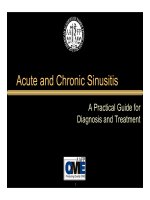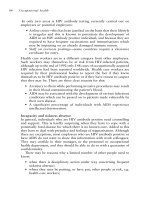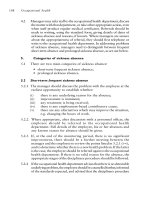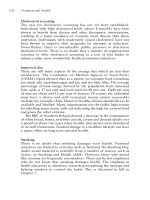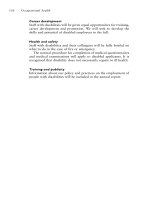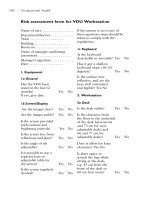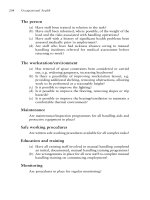Occupational A Practical Guide For Managers_7 docx
Bạn đang xem bản rút gọn của tài liệu. Xem và tải ngay bản đầy đủ của tài liệu tại đây (306.7 KB, 24 trang )
156 Occupational health
Career development
Staff with disabilities will be given equal opportunities for training,
career development and promotion. We will seek to develop the
skills and potential of disabled employees to the full.
Health and safety
Staff with disabilities and their colleagues will be fully briefed on
what to do in the case of fire or emergency.
The normal procedure for completion of medical questionnaires
and medical examinations will apply to disabled applicants. It is
recognised that disability does not necessarily equate to ill health.
Training and publicity
Information about our policy and practices on the employment of
people with disabilities will be included in the annual report.
157
Chapter 10
The employment of women
Unless career women organise help to handle the base camp, they
are left to do everything—their jobs, be a parent, support husband
and arrange family gatherings like Christmas.
(Siobhan Hamilton-Phillips, DPS Consultants Ltd, Newsletter,
December 1993)
Women account for over 44 per cent of the people in paid employment.
The numbers of women with dependent children and those remaining at
work during, and for a greater part of, their pregnancy are increasing.
Legislation has been enacted making discrimination on the grounds of sex
unlawful and affording protection in such matters as pay and the
promotion of equal opportunities. This legislation is discussed as are the
implications for employers. The chapter highlights the dilemma thrown up
when the need to provide a safe place for work conflicts with the
individual’s right to privacy in such matters as actual or intended
pregnancy. Family-friendly policies are outlined. The change in the state
retirement age for women is noted against the background of precedent-
making judgements in respect of pension arrangements.
Introduction
There are now over 10 1/2 million women aged between 16 and 59 in
paid employment, which represents an increase of 1 1/2 million in the last
decade. Women account for over 44 per cent of those in paid
employment. There has been a steady increase in the number of working
women who have dependent children, and the number of single mothers
has also steadily increased. Another trend is for women to remain at
work during, and for a greater part of, their pregnancy.
As women have sought (and legislation has been enacted in the field
of) equal opportunities, they have entered into traditionally male areas of
work, although some 60 per cent of employed women are engaged in the
clerical, educational, health and personal service sectors of the economy.
158 Occupational health
Legislation
In addition to general health, safety and welfare legislation there are
other statutes which must be observed. The Sex Discrimination Act 1975
(as amended in 1986) and the Equal Pay Act 1970 are designed to
remove discrimination and promote equal opportunities, while the Trade
Union Reform and Employment Rights Act 1993 affords protection for
women employees when they are pregnant.
The Equal Pay Act
The Equal Pay Act 1970 is concerned with the terms and conditions in a
woman’s contract of employment, which must clearly show the rate of
remuneration she is, or is going to be, paid, and contains provisions
designed to ensure equality in terms of pay. The Act defines three
conditions which must be met for a woman to succeed in a claim for
equal pay under the arrangements provided by the Act. They are:
• The male comparator must be employed at the same time.
• The male comparator must be employed by the same or an
associated employer at the same establishment or at a different
establishment belonging to the same or an associated employer,
where common terms and conditions of employment are observed
either generally or for relevant classes.
• The female must be engaged on like work or work rated as
equivalent or work of equal value to that of the male comparator.
The Sex Discrimination Act
The Sex Discrimination Act 1975 (as amended in 1986) is designed to
prevent unlawful discrimination against women, and against men on the
same grounds or against a married person of either sex on the grounds of
that person’s marital status. Discrimination is permitted in those special
arrangements emanating from pregnancy and childbirth.
There are three types of unlawful act to consider:
• Direct discrimination, which is where a person of one sex is treated
less favourably than a person of another and the sex of that person
is the reason for the unfavourable treatment.
• Indirect discrimination, which is where a person applies a
condition or requirement to another, such that the proportion of
The employment of women 159
persons of one sex who will not be able to meet that condition or
requirement is much larger than the other sex. Obviously, if the
employer is able to show that the condition or requirement is
justified, irrespective of sex, no indirect discrimination will have
taken place.
• Victimisation, which arises because the person has brought
proceedings or has given evidence or information in connection
with proceedings under the Act or the Equal Pay Act 1970. It is
also unlawful to victimise a person because the individual has
done something in relation to either Act to any person, including
the discriminator, or has made allegations of a contravention of
either Act unless the allegation was false and not made in good
faith.
In the second part of the Act five types of unlawful discriminatory act are
specified and are concerned with:
• The arrangements a person makes for the purpose of determining
who shall be employed. These arrangements have to ensure that job
opportunities are available to all, irrespective of sex.
• The terms on which a person offers employment to another. There
are exceptions, one of which is pay, covered by the Equal Pay Act
1970, and differences where the employer can show that these are
to do with genuine material difference between the two applicants
which has nothing to do with their sex.
• Refusing or deliberately omitting to offer employment because of a
person’s sex.
• The way a person offers access to opportunities for promotion,
transfer or training, or to any other benefits, facilities or services, or
refuses or deliberately omits to afford access to those opportunities.
• Dismissing a person or subjecting him or her to any other
detriment. While it is obvious that if in a redundancy situation a
person is selected for dismissal by reason of sex an unlawful
discriminatory act has occurred, the question of detriment is
complex. If a person is being subjected to unpleasant treatment of
a sexual nature, sexual harassment, this may or may not amount to
a detriment. The individual circumstances such as whether or not a
person of the other sex would have been vulnerable to the same
treatment and the degree to which there has been injury to the
person’s feelings have to be taken into account in arriving at a
conclusion.
160 Occupational health
The Trade Union Reform and Employment Rights Act
The Trade Union Reform and Employment Rights Act 1993 affords
individual employment rights which include those relating to maternity
leave, maternity pay and the right to return to work as well as protection
against unfair maternity dismissal. Every woman employee is entitled to
14 weeks’ statutory maternity leave subject only to:
• giving the employer a written notice 21 days before her maternity
leave period begins, stating that she is pregnant and giving the
expected week of childbirth;
• giving the employer notice again at least 21 days in advance of the
date on which she intends her maternity leave period to begin;
• producing medical evidence in the form of a certificate from a
registered medical practitioner or midwife stating the expected
week of childbirth if the employer requests this.
If an employee wishes to return to work before the end of her maternity
leave period, she must give her employer at least seven days’ notice of her
intended return date.
If the employee intends to return to work she must include in her
written notice of her pregnancy a statement that she intends to return to
work, and she must give 21 days’ notice of return at the end of her leave.
During the statutory maternity leave period the employee will be entitled
to all her contractual benefits apart from pay; a new statutory maternity
pay scheme is introduced under this Act.
Dismissal or selection for redundancy on pregnancy- and maternity-
related grounds is automatically unfair; there are no qualifying service
conditions and women dismissed while pregnant or during their statutory
maternity leave period will automatically be entitled to written reasons
for dismissal. Women who would otherwise be suspended from work on
health and safety grounds have to be offered suitable alternative work. If
suspended, they will be entitled to their normal pay.
Currently, to qualify for the right to return to work up to 29 weeks
after childbirth, the employee must have worked for the employer for at
least two years at least 16 hours per week or for five years at least eight
hours per week. A recent court ruling suggests that qualifications in
respect of part-time work could be in breach of European Court
rulings.
Under the terms of European law, Article 119 of the Treaty of Rome
provides that: ‘Each member state shall maintain the application of the
principle that men and women should receive equal pay for equal work.’
The employment of women 161
The UK government appears reluctant to accept European Directives
on other women’s issues and has opted out of the Social Chapter under
the Maastricht Treaty.
Other areas, such as pension rights and retirement ages, have been
subject to decisions in the European Court, principally in the Barber case
(Barber v. Guardian Royal Exchange 1990) which established that from
17 May 1990 sex equality in pension matters had to apply, while the Ten
Oever case (Ten Oever v. Stichting 1993) reaffirmed the principle of sex
equality and ruled on the meaning of the non-retrospective provision in
the Barber judgment. The significance of this is that benefits need to be
equalised only in respect of post-17 May 1990 service and that is the date
from which spouses’ benefits must be equalised.
The British government has recently announced that the state pension
age will be equalised at 65, the equalisation to be introduced
progressively between the years 2010 and 2020.
Health and safety
The European Commission has adopted a directive aimed at improving
the health and safety of pregnant workers, those who have recently given
birth and those who are breast-feeding. The Management of Health and
Safety at Work Regulations have been amended accordingly (Regulation
13A-C). Under this comprehensive amendment a special risk assessment
is required with respect to women who fulfil the above conditions. Where
a risk is demonstrated, the hours of work or working conditions should
be altered to avoid the risk where it is reasonable to do so. If it is not
possible to remove the risk and alternative work is not available then the
employee must be suspended with continued remuneration. Annex 1 to
the Council Directive provides a list of agents, working conditions and
processes that an employer must assess for risk; Annex 2 gives a list of
agents and working conditions to which pregnant workers must not be
exposed.
The hazards which must be assessed may be chemical, physical or
microbiological.
Chemical hazards
The area which has probably caused most concern is that of chemical
hazard to reproduction. It is perhaps important to say here that the
vulnerability of the male reproductive system cannot be ignored. For
example, infertility was demonstrated in male pesticide workers exposed
162 Occupational health
to the chemical dibromochloropropane. It has been suggested that there
is a higher incidence of leukaemia in the children of fathers working in
nuclear processing plants.
It should also be noted that exposure to chemicals outside the work
situation through alcohol consumption and smoking has been clearly
associated with increased risk of miscarriage.
Several groups of chemicals have been implicated in causing
reproductive impairment.
Lead
In 1989 the UK Factory Inspectorate reported that women exposed to
lead at work were more likely to miscarry where there was significant
environmental contamination and poor standards of hygiene. It is now
known that children and adult females are more sensitive to lead
exposure. In recognition of this, the Lead Regulations require that any
woman of reproductive capacity should be withdrawn from work which
exposes her to lead when the lead level in her blood reaches 40 ug/100ml
or above. In contrast, men may continue to work up to a 70ug/100ml
blood level.
Sterilising agents
Ethylene oxide is a fumigant for food stuffs and textiles and has been
used in the sterilisation of surgical instruments. Accidental exposure has
been shown to cause chromosomal damage. One study showed an
increased incidence of abortions among hospital staff using ethylene
oxide to sterilise instruments (Hemminki 1985).
Pregnant women should not be involved in work using ethylene oxide
unless the process is totally enclosed.
Cytotoxic drugs
There is now widespread use of these drugs in the treatment of cancer.
Safe working practices for administration and reconstitution only within
laminar flow cupboards reduce risk to acceptable levels. There is no
restriction on pregnant nurses being involved in administration under
controlled circumstances. Most health trusts, however, restrict their
involvement in reconstitution during the period of pregnancy and
breastfeeding.
Anaesthetics
Several studies seemed to show an increase in spontaneous abortion among
theatre staff exposed to low concentrations of anaesthetic gases. However,
a review of 14 epidemiological studies failed to show any increased risk.
The employment of women 163
Physical hazards
Ionising radiation
This is used increasingly in industrial processes. The UK Ionising
Radiation Regulations set specific limits of exposure for women of
reproductive capacity and pregnant women.
Non-ionising radiation
This type of radiation includes radio waves and ultraviolet light.
Attention has also focused on the small amount of electromagnetic
radiation emanating from visual display units (VDUs). Several studies
have shown no evidence that there is any increase in the number of
miscarriages and birth defects among women working with VDUs.
Studies by the National Radiological Protection Board confirm that
levels of radiation are well below recommended acceptable levels.
Noise
There is a suggestion that exposure of the mother during pregnancy to
high levels of noise may result in high frequency hearing loss in the child.
However, studies have so far proved inconclusive.
Exercise
The increased number of women in the armed forces and their
assumption of a full role has shown that high degrees of physical exercise
may result in the transitory loss of menstruation. This has also been seen
in ballet dancers. There appear to be no long-term effects. However,
women are more at risk of musculoskeletal damage during pregnancy.
Microbiological hazards
Chicken pox, rubella and cytomegalovirus infection during pregnancy
can have an adverse effect on the foetus. Pregnant women should avoid
exposure to these infections. Clearly, those engaged in work with
children or health care are more likely to be at risk.
Reducing the risk
As we have seen, in compliance with the Health and Safety at Work etc.
Act 1974 the employer is required to provide a safe place of work as far
as is reasonably practicable. This was taken to mean that it should be
safe for the majority of workers. However, the new legislation in relation
to pregnant women requires the workplace to be safe for them as a
special group.
164 Occupational health
Do employers, therefore, have the right to exclude from the workplace
those individuals who are particularly vulnerable for whatever reason? In
situations which may be hazardous to women of reproductive age, as
defined by the recent legislation, how is an employer to know of the
pregnancy while still respecting the individual’s privacy?
The Health and Safety Commission defines a woman of reproductive
age as ‘any woman capable of conceiving and carrying a child’. It
suggests that any woman should be presumed to have reproductive
capacity unless she provides a medical certificate stating otherwise. This
could, of course, have wide-ranging implications for the employment of
women. The Equal Opportunities Commission (EOC) has stated that
acceptable levels of toxic exposure may need to be lower for women of
reproductive capacity. To achieve this in a reasonably practicable way,
organisations can either:
• suspend the employee on medical grounds;
• offer alternative work;
• dismiss the employee;
• give the employee the option of remaining, having explained the
risks.
Any of these solutions may leave the organisation open to a claim of
sexual discrimination. Alternatively, any subsequent damage to the
foetus, if preventive action is not taken, may result in litigation and even
prosecution under health and safety legislation.
The EOC has also indicated that questions about pregnancy and
related matters on pre-employment questionnaires may be seen as
discriminatory. Employers may well be caught between a rock and a hard
place in their efforts to achieve fairness in the employment of women. At
present, there is little case law to assist.
Family-friendly policies
Working women find it difficult to delegate domestic and family
responsibilities. While social change is taking place, the norm is still for
the woman to accept the greater portion of responsibility for the day-to-
day management of the home, children, husband, and sometimes ageing
relatives or grandchildren.
Company policies for women should recognise that, unless family-
friendly policies are put into place, there is a danger that, in respect of
women employees, performance may suffer and sick leave, absence and
labour turnover increase.
The employment of women 165
In Corporate Culture and Caring (1993), produced for Business in the
Community by the Institute of Personnel Management, family-friendly
practices are said to enable an organisation to:
• make full use of the skills, experience and potential of all staff and
thereby acquire the best person for the job;
• increase its efficiency, profitability and competitiveness;
• attract and retain committed, skilled and experienced staff, thereby
recouping investment in training (and avoiding unnecessary
recruitment-associated costs);
• increase the number of women who return to work following
maternity leave;
• enhance the organisation’s image with customers and staff through
demonstrable commitment to equal opportunities.
The booklet gives examples of savings which can be made and an
estimate of the costs which could be incurred in the provision of childcare
support.
Initiatives may include options to provide childcare:
• workplace nurseries;
• partnerships with other organisations;
• private nursery places;
• sponsored child minders;
• childcare allowances and vouchers;
• after-school schemes;
• holiday play-schemes.
Another area for consideration is working arrangements and their
flexibility. Flexible working can embrace:
• part-time working;
• job-sharing;
• flexible working hours;
• career or employment breaks;
• term-time working;
• flexi-place and teleworking.
All these should be supported by an effective information and advice
service which specifically provides for dealing with crises.
Training and development
Business in the Community’s Opportunity 2000 has been influential in
gaining publicity for positive action designed to achieve genuine equal
166 Occupational health
opportunities for women in employment. Training initiatives have been
taken to facilitate the movement of women up the hierarchy into
management positions and across into male-dominated occupations.
While positive discrimination is unlawful in the UK, single-sex training
designed to help women to realise their potential for management and
male-dominated occupations is not. In terms of well-being, working
women should understand the nature of stress and the human response
to it, to recognise it in themselves and learn to manage the conflicting
demands made on them.
Other types of women-oriented training and development
programmes include those designed to address individual lack of
confidence, especially in the areas of career potential and financial
planning. There has also been an increase in help for women in order to
improve their personal safety, particularly where they are employed in
jobs exposing them to risk; for example, in occupations which provide a
service to the general public and those involving driving, as in sales
representative positions.
Conclusion
While this chapter has focused on the employment of women and
described the issues and factors involved, employers are beginning to
recognise that policies and practices initiated to benefit female
employees, the lessons learned from them and the improvements made,
can also profitably be extended to their male employees.
Part IV
169
Chapter 11
The use of display screen equipment
Write the vision, and make it plain upon the tables, that he may run
that readeth it.
(Habakkuk)
The Health and Safety at Work etc. Act requires all employers to ensure
the health and safety of their workforce. Special regulations apply to the
use of display screen equipment, including any alphanumeric or graphic
display screen. Employees covered by this legislation include those who use
such equipment for an hour or more each day as a significant part of their
work. This chapter outlines the requirements of the regulations. A
checklist to facilitate assessment of the workstation is provided with
guidance on its use. Simple arrangements for risk reduction are described
in relation to basic ergonomics. Health issues such as repetitive strain
injury and eye problems are considered in detail and guidance is given on
avoiding health problems. At the end of the chapter a model chair-
purchasing policy, a policy for eye and eyesight testing, and a policy for the
implementation of the regulations are provided.
Introduction
The Health and Safety at Work etc. Act 1974 requires all employers to
ensure the health and safety of their workforce. This is underpinned by
regulations which are industry or hazard specific (for example, the Noise
at Work Regulations). Recent legislation stemming from the EC
Framework Directive applies across all employment sectors and is proving
to be provocative, time-consuming and costly. A Directive places
obligations on a member state to enact domestic legislation to achieve the
requirements of the Directive within a stated time limit. In response to the
Framework Directive, six sets of regulations (the so-called six pack) have
been enacted under the Health and Safety at Work Act. The fifth of these
is the Health and Safety (Display Screen Equipment) Regulations 1992.
Guidance on implementation has been issued by the Health and Safety
170 Occupational health
Commission. The aim of the regulations is to reduce the risk to staff of an
occupational injury resulting from the use of display screen equipment.
Scope of the regulations
The scope of these regulations has been clearly defined and applies to any
alphanumeric or graphic display screen regardless of the particular
display process. The definition extends beyond the typical office visual
display unit (VDU) and covers microfiche, lighted crystal displays and
process equipment.
The workstation also falls within the regulations. The definition
includes an assembly of display screen equipment (DSE) with or without
keyboard or software, and any accessories to the equipment such as
telephone, printer, document holder, work chair, work desk or work
surface. It also includes the immediate workplace environment.
The term ‘user’ is applied to anyone for whom the use of DSE forms
a significant part of his or her normal work. This has sometimes been
difficult to interpret but it seems sensible to define a user as anyone to
whom the following criteria apply:
• Their work often requires the use of a display screen for an hour or
more.
• The display screen is used by them on most days.
• Their job could not be done without use of the display screen.
• The ability to use the display screen comes within their job
specification.
Requirements of the regulations
Regulation 2—Analysis of workstation and
risk reduction
Employers are obliged to analyse each workstation (as defined above) in
order to assess any risk to the user’s health and safety. These assessments
must be recorded. Having identified any risks, employers must reduce
them to the lowest level reasonably practicable.
Regulation 3—Timing of risk assessment and reduction
A workstation brought into use after 1 January 1993 must immediately
meet the requirements. This includes workstations which are altered
substantially or relocated. A workstation already in use on 1 January
The use of display screen equipment 171
1993 must meet the minimum requirements by 31 December 1996.
However, they must be assessed as soon as possible after 1 January 1993
to determine any immediate significant risk to health.
Regulation 4—Daily work and breaks
Employers must organise working practices so that work on DSE is
regularly interrupted by breaks or other activities. It is becoming
increasingly clear that, even with the ergonomically best possible
workplace, health problems may arise if workers undertake long periods
of work within a 24-hour period and do not take regular breaks.
Regulation 5—Eye and eyesight testing
Employers must ensure that new employees are given the right to have an
appropriate eye and eyesight test before commencing work. Employers
must ensure that current users are given the right to have an appropriate
eye and eyesight test on request.
Tests must be offered at regular intervals after starting work, and
where a user experiences eye problems which it is reasonable to conclude
are caused by working with DSE.
Employers must provide users with special corrective apparatus, i.e.
spectacles suitable for the work being done, if their normal corrective
appliances cannot be used and tests show that such provision is necessary.
Regulation 6—Training for users
Employers must ensure that adequate health and safety training is given
to an intended user before use of the workstation has commenced and to
all users whenever the arrangements, including software, at their
workstation are substantially modified.
Regulation 7—Information for users
Employers must ensure that every user is given complete and
comprehensible information about what has been done to meet the
requirements of the regulations, about the entitlements to eye and
eyesight testing, and training arrangements.
Assessing the workstation
A helpful first step in workstation assessment is the use of a questionnaire
to be completed by users. The manager of each department should
172 Occupational health
identify all workstations and users. Where there is significant variation
between users and the time spent at workstations, it may be appropriate
to start assessment with those who average over four hours daily at this
work. A suitable questionnaire is given at the end of this chapter (see
pages 180–3). The questionnaires should be returned to a designated
person or department, depending on the size of the organisation and
available skills. This may be the occupational health or safety or
personnel department or, in the absence of these, the departmental
manager. The completed questionnaires will indicate where there appear
to be unsatisfactory features in the workplace, which should then be
assessed by a competent person. In the absence of trained health and
safety personnel, companies may decide to train staff to fulfil this role or
may obtain advice from external consultants.
Factors to consider in risk assessment
The aim of risk assessment is to establish the situation with regard to the
legal requirements for DSE (terminal and keyboard), the workstation, the
environment and operational practices, and to discover current health
problems.
Display screen equipment
Each terminal should:
• be adequately tested and guaranteed by the manufacturer as
complying with relevant regulations;
• be maintained regularly;
• be provided with contrast and brightness controls;
• have an adjustable screen with the capacity to swivel and tilt;
• have easily read characters on screen without flicker or other
distraction.
The keyboard should have non-reflective surfaces.
Workstation
The British Standards Institution has published standards for visual
display terminals, visual display workstations and their design.
Equipment should be provided to enable the operator to adjust to the
optimum working position. This should include a chair which is
adjustable for height, has the facility to alter the height and tilt of the
back support, and has a base of five feet on rollers. There are many
suitable chairs available, but the variation in cost is enormous. It is
The use of display screen equipment 173
therefore advisable to establish a policy on the central purchase of chairs
(see the sample policy at the end of this chapter; pages 163–84). Users
should be offered a small range of similarly priced chairs so that they can
choose the most comfortable one for them. The hardness of the seat and
the absence or presence of arms are the sort of variables which it is worth
considering.
A document holder should be provided where appropriate. Bright and
reflecting surfaces on adjacent furniture should be avoided. There should
be adequate space (a minimum of 3.7 square metres per workstation).
The work surface should be large enough to allow the comfortable
arrangement of all equipment, and it should also be of a suitable height
for DSE work with sufficient leg room. The use of a foot rest should be
considered for short users.
Environment
Background noise should be kept to a minimum. Heating and ventilation
should be kept at a suitable level.
Lights should be so arranged to avoid reflection and glare. General
light levels should be 300–500 lux. In some cases where lower level
general lighting is preferred, individual desk lights may be appropriate.
Workstations should be sited at right angles to windows and where
necessary natural light should be controlled by blinds or curtains.
Operational practices
Long periods of intense, continuous work must be avoided by varying work
tasks as well as by suitable rest and relaxation periods. This aspect of the
legislation has probably been the most difficult to implement. Many jobs
seem to require prolonged use of DSE. Natural breaks do not occur and if
insisted on may cause more problems. Lack of rest breaks may be as much
to do with the operator’s persistence and conscientiousness as with the
nature of the task. The intensity of work at the screen as well as its timing
can be significant in the development of health problems. It is essential
that managers control levels of screen work. A ten-minute break away
from the screen every hour has been recommended.
Certain keyboard configurations such as QWERTY have been
implicated in the development of work-related upper limb disorder
(WRULD). However, many of the cases reported have been associated
with particular repetitive work such as editing documents with continued
use of the function keys. Software developments and proper training can
help to avoid these repetitive activities.
There are so many tasks which need DSE that organisation of work
may need to be considered on a job-by-job basis around what is
174 Occupational health
reasonably practicable and what is operationally possible in order to
avoid hazard to health. Strict interpretation of the suggested ten-minute
break initially led to much confusion and industrial relations problems.
However, commonsense seems to have prevailed.
Arrangements for risk reduction
The assessment, both individual and by a competent person, will have
revealed where requirements are not being met.
Risk reduction must be implemented immediately where a significant
risk has been identified, particularly if the user is already experiencing
health problems. It should not be assumed that risk reduction measures
will be costly. To a great extent, problems seem to arise because
operators are not using their equipment correctly, do not have
appropriate software and are not taking reasonable breaks. The single
most common problem is inappropriate seating or seating used
inappropriately. Figure 11.1 shows the correct position for working with
DSE. Unsuitable positioning may develop because the height of the seat
has not been, or cannot be, adjusted; the operator’s feet do not touch the
floor because he or she has short legs and there is no foot rest; the
operator’s vision is not suitably corrected for screen work; or there is not
enough desk space. Risk reduction should be addressed in five ways:
• training in good practice;
• repositioning of equipment and chair adjustment;
• provision of equipment such as foot rest, document holder;
• appropriate lighting;
• work redesign.
Health issues
Discussion about the use of DSE and hazards to health is out of all
proportion to the risk involved. It has been suggested that a number of
conditions may arise from its use. These are considered below.
Effects on the eyes
Using DSE does not damage the eyes or the eyesight, nor does it cause
deterioration in existing eye conditions. However, pre-existing eyesight
defects may be highlighted by the intense visual effort that such work
entails. Frequent changes in the required focal length for the visual task
(from document holder to screen to keyboard) may show up more
The use of display screen equipment 175
sluggish eyesight accommodation in older operators, resulting in
symptoms of eye fatigue such as sore eyes and headaches. Similarly,
eyesight correction may be required to read the screen, which is at a
different distance (30 cm) from the normal reading position. Eye fatigue
may also result from poor positioning or glare. The requirement for eye
and eyesight tests within the regulations addresses these issues.
Fatigue and stress
The relationship between the operator and the display screen is often
more intense than that experienced in typewriting. The speed of
operation and the lack of natural breaks (such as changing the paper)
may be influential here. In many operations there is less operator control
of speed of response—the machine may seem to be working the operator.
Systems of work should ensure that relaxation periods are inevitable.
Figure 11.1 The correct position while working at display screen equipment
176 Occupational health
Radiation
There is a continually expressed anxiety that display screens emit
damaging ionising and non-ionising radiation. Exhaustive tests by the
National Radiological Protection Board have shown that emission levels
are well below national and international safe limits and there is no risk.
Facial dermatitis
This is another red herring, probably associated with the unfounded
belief that operators are being exposed to damaging radiation.
Pregnancy
Anxiety about risks to pregnant operators arose from the concerns over
radiation and the apparent increased incidence of pregnancy
abnormalities. A number of reliable studies have demonstrated that there
is no increased risk of miscarriage or abnormality.
Epilepsy
DSE does not cause epilepsy. However, photosensitive epilepsy occurs in
a small percentage of the population. Individuals with this disorder may
be susceptible to flickering screens. Such individuals should seek medical
advice before beginning work with DSE.
Work-related upper limb disorder
There is no doubt that work with DSE can cause upper limb symptoms.
Attempts have been made to group symptoms under various titles such
as repetitive strain injury (RSI) and work-related upper limb disorder
(WRULD). WRULD is certainly a better term because it does not
include the requirement of repetitive action. However, with such a
variety of symptoms, these umbrella terms tend to obfuscate rather
than clarify the situation. Sitting in a fixed and often unsuitable
position for long periods, undertaking repetitive finger, hand or wrist
movements, particularly if there are time or other pressures to finish the
work, can result in pain and stiffness in the neck, shoulders and arms.
Generally, these symptoms disappear with rest, but in certain cases,
where symptoms are ignored and pain is ‘worked through’, more
disabling and long-term symptoms may develop and be labelled as
some form of WRULD.
The use of display screen equipment 177
Such disorders have been prescribed (entitling the sufferer to worker’s
compensation) since 1908. Conditions such as telegraphist’s cramp and
writer’s cramp were prescribed between 1908 and 1922. These
conditions were described as cramp of the hand or forearm owing to
repetitive movements. The 1965 Annual Report of HM Chief Inspector
of Factories stated that:
Traumatic inflammation of the tendons or tendon sheaths of the
hand or muscles inserted in the lower forearm is a non-infective
condition affecting the musculo-tendinous function of the synovial
lining of the tendon sheaths or the tendons themselves. It is caused by
the constant repetition of small quick movements. The clinical
features are local pain, swelling, tenderness and sometimes redness.
In the absence of complicating factors, the condition usually subsides
with rest. The occupational cramps form a somewhat similar set of
conditions which occur in people who have to carry out repeated fine
movements such as writers, telegraph operators and the like. An
underlying psychoneurosis is suspected in many cases but the
condition does not often respond to psychological treatment.
(cited in Tindall 1993)
In October 1990 the Health and Safety Executive published Guidance
Note MS10 ‘Work-related Upper Limb Disorders: A Guide to
Prevention’. The term ‘upper limb disorder’ encompasses a range of
conditions affecting the soft tissues of the hand, wrist, arm and shoulder.
The guidance note describes symptom patterns, possible causal links,
preventive measures and the elimination of risk. Although employer
responsibility is clearly established, there is less help with diagnosis,
treatment and rehabilitation.
It will be clear that the term WRULD includes a number of conditions,
some of which such as tenosynovitis and carpal tunnel syndrome can be
diagnosed by objective tests; others may be less amenable to objective
evaluation and can be diagnosed on symptomatology alone. Training of
operators in the early identification of symptoms is essential. This can
result in early intervention both in terms of treatment and correction of
unsatisfactory work practices and conditions. There is little doubt that
WRULD can, and should, be avoided.
It is clear, therefore, that the only significant health risk from the
operation of DSE is WRULD. Every effort should be made to ensure that
work organisation does not allow it to develop, and that operators are
provided with information on the avoidance and early identification of
the condition.
178 Occupational health
Over the years there have been many cases of claims against
employers in relation to symptoms arising from repetitive manual tasks
(e.g. Mountenay v. Bernard Matthews plc 1993). This has established
some basic principles:
• The employee must be warned of the risk.
• The employee must be alerted to the possible symptoms.
• The employee must be trained in the correct posture and use of
DSE.
• The employee must be advised to report problems immediately.
A court will consider whether the operation was known to be associated
with WRULD, whether the employer attempted to reduce the risk, and
whether the symptoms were a result of the work. In a judgment in 1993,
the judge ruled that RSI did not exist as an identifiable syndrome,
although this decision is likely to be appealed against (Murghal (Rafiq) v.
Reuters 1993). Stevenson has reviewed the current legal position
(Stevenson 1994).
Training
Employers must ensure appropriate DSE health and safety training,
which should cover the following issues:
• information on the regulations;
• the user’s role in carrying out assessments;
• how to undertake workstation assessments;
• the user’s role in the recognition of developing health problems;
• simple explanations of the causes of risk;
• user-initiated actions and procedures to reduce risk;
• organisational arrangements for reporting problems.
Adequate basic training can be carried out in an hour, if there are
wellprepared course material, guidance notes and instructions which can
be taken away and studied. All training must be recorded.
Eye and eyesight tests
There has been considerable discussion on the rather Draconian
requirements of the EC legislation in this context, and it has undoubtedly
been fuelled by the self-interested parties. In most organisations it has
The use of display screen equipment 179
been possible for employers and employees to reach a reasonably
practicable mode of operation, bearing in mind that an employee is given
the right to have an appropriate eye and eyesight test on request and that
the test is an entitlement not an obligation of the employee.
The tests should be made available to all new DSE users, to all current
DSE users following promulgation of the legislation (December 1992),
and at intervals as suggested by the examining ophthalmic optician or
medical practitioner, and to all DSE users who have developed related
eye symptoms.
In practice, most large organisations have offered eyesight screening to
all users. This has generally been carried out by in-house occupational
health staff using apparatus such as the Master Vision Screener (MAVIS)
or the Keystone Vision Screener. A low level of previously unrecognised,
uncorrected disorders has been detected (less than 1 per cent in these
surveys). Certain opticians have developed facilities and expertise for
testing DSE users with particular reference to middle-range vision (50–
60cm) and organisations can arrange contracts for eye testing as
required. An example of an eye and eyesight test policy is given on page
186. Most employers have found that there has not been an enormous
demand for full eye testing.
Conclusion
The use of DSE increases daily in the workplace, thereby potentially
putting more employees at risk. Consideration of risk factors at the
planning and development stage can avoid long-term problems. (A
sample policy is given at the end of this chapter; see pages 187–90.)
Contracts with suitable suppliers for chairs and eye tests can help to
lower the potential cost of implementing the regulations.



